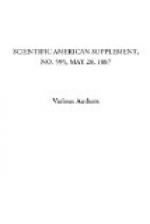It is due to a species of plant, and although that
species is small, it is as easily separated from allied
plants as species of flowering plants can be separated
from each other. This plant was known in South
America before it made its appearance in this country.
It has been traced from South America to North America,
and to Australia, and it made its first appearance
in Europe in Belgium, in 1844, and within a very few
days after it appeared in Belgium, it was noticed in
the Isle of Wight, and then within almost a few hours
after that it spread over the whole of the south of
England and over Scotland.... When the disease
begins to make its appearance, the fungus produces
these large oblong bodies (conidia), and the
question is how these bodies are spread, and the disease
scattered.... I believe that these bodies, which
are produced in immense quantities, and very speedily,
within a few hours after the disease attacks the potato,
are floating in the atmosphere, and are easily transplanted
by the wind all over the country. I believe this
is the explanation of the spread of the disease in
1844, when it made its appearance in Belgium.
The spores produced in myriads were brought over in
the wind, and first attacked the potato crops in the
Isle of Wight, and then spread over the south of England.
The course of the disease is clearly traced from the
south of England toward the midland counties, and
all over the island, and into Scotland and Ireland.
It was a progress northward.... This plant, the
Peronospora infestans, will only grow on the
Solanum tuberosum, that is, the cultivated potato....
Just as plants of higher organization choose their
soils, some growing in the water and some on land,
so the Peronospora infestans chooses its host
plant; and its soil is this species, the Solatium
tuberosum. It will not grow if it falls on
the leaves of the oak or the beech, or on grass, because
that is not its soil, so to speak. Now, the process
of growth is simply this: When the conidia fall
on the leaf, they remain there perfectly innocent
and harmless unless they get a supply of water to
enable them to germinate.... The disease makes
its appearance in the end of July or the beginning
of August, when we have, generally, very hot weather.
The temperature of the atmosphere is very high, and
we have heavy showers of rain.”
The warmth and moisture are, in fact, the conditions necessary for the germination of the conidia. Their contents (zoospores) are liberated, and quickly grow in the leaf, and soon permeate every tissue of the plant.




